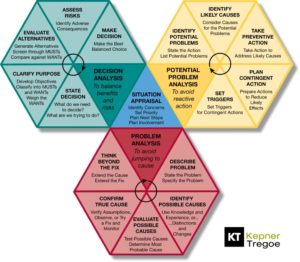Kepner-Tregoe Demystified

No, not the names of the two muppets in the balcony, but a mysterious problem management technique mentioned in the ITIL® guidance.
In “Service Support” (the v2 “blue book”) it was summarised as the following:
- Defining the Problem
- Describing the Problem with regard to identity, location, time and size
- Establishing the possible causes
- Testing the most probable cause
- Verifying the true cause
I confess that I always thought that this was simply a description of the scientific method and proof that social scientists could put their name to anything!
However, I was doing Charles Kepner and Benjamin Tregoe a great disservice, as their approach was to develop a method of structured thinking that went much further than the summary above.
In broad terms, there are four separate and distinct thinking processes. Some or all of these can be applied to many situations, including Problems, but also to Major Incidents and Continuity Events.
The thinking processes (in no particular order) are:
- Problem Analysis – Conduct root cause analysis on complex problems.
- Decision Analysis – Make tough decisions aligned with operational priorities.
- Situation Appraisal – Identify and plan for the resolution of high-priority issues.
- Potential Problem/Opportunity Analysis – Understand and proactively manage risks and opportunities.
Not every situation will require each of these tools, for example, sometimes understanding the root cause is not necessary for decision making – one doesn’t need to know why the fire started to work out the best way of tackling it! In this case, understanding “why” takes place after the fire is out.
Each process is intentionally distinct and should remain so. There is no implied sequence. So Situation Appraisal may happen repeatedly during a Major Incident, as the situation develops and new information comes to light, interleaved with several different decision points. AKA “Don’t cross the streams!”
The ITIL® Team are expecting to use Kepner-Tregoe ideas in a number of different best practice situations over the coming months, so watch this space for additional introductory posts on each of the four “thinking processes”.
Further Reading
Kepner-Tregoe Inc offers training and consultancy services and have released the first few chapters of Kepner and Tregoe’s text book “The New Rational Manager” on their website:
New Rational Manager sample chapters 1 & 2





Recent comments